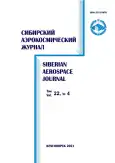Alternative method of solar simulation for thermal vacuum tests of spacecraft
- Authors: Shevchuk A.A.1
-
Affiliations:
- JSC Academician M. F. Reshetnev “Information Satellite Systems”
- Issue: Vol 22, No 4 (2021)
- Pages: 672-686
- Section: Section 2. Aviation and Space Technology
- Published: 20.12.2021
- URL: https://journals.eco-vector.com/2712-8970/article/view/562947
- DOI: https://doi.org/10.31772/2712-8970-2021-22-4-672-686
- ID: 562947
Cite item
Abstract
Solar simulators based on gas-discharge xenon lamps, used to obtain the thermal state of objects for thermal vacuum testing of spacecraft, are one of the key, most complex and energy-consuming elements of test equipment. The complexity of the optical system, the large number of optical elements, the need for constant monitoring of their condition, tuning and adjustment by highly qualified personnel significantly complicate the obtaining of required luminous characteristics, mainly the spatial uniformity of the irradiance. Another common drawback is their low energy efficiency, which does not exceed 10 %. We proposed an alternative method of solar simulation using solid-state luminous sources – high-efficiency LEDs, with their placement without a bulky and complex optical system directly in a thermal vacuum chamber. At the same time, one of the most difficult problems of adapting to the conditions of thermal vacuum tests is to provide the necessary luminous characteristics. The required wavelength range, spectral match are obtained by combining assemblies of high-efficiency LEDs of six different wavelengths and halogen lamps. We carried out a number of experiments, including measuring the luminous characteristics of alternative luminous sources and mathematical modeling of the matrix emitter. As a result, the possibility of using the proposed method for thermal vacuum tests of spacecraft was confirmed; the luminous characteristics of the model meet the requirements, and in terms of uniformity of irradiance and energy efficiency, they significantly exceed those of traditional solar simulators.
About the authors
Andrey A. Shevchuk
JSC Academician M. F. Reshetnev “Information Satellite Systems”
Author for correspondence.
Email: shevchukaa@iss-reshetnev.ru
testing engineer of the thermal vacuum tests department
Russian Federation, 52, Lenin St., Zheleznogorsk, Krasnoyarsk region, 662972References
- GOST R 56469–2015. Apparaty kosmicheskiye avtomaticheskiye. Termobalansnyye i termovakuumnyye ispytaniya. [State Standard R 56469-2015. Automatic spacecrafts. Thermal balance and thermal vacuum tests]. Moscow, Standartinform Publ., 2015. 11 p.
- Kravchenko S. V., Nesterov S. B., Roman’ko V. A., Testoyedov N. A., Khalimanovich V. I., Khristich V. V. [Approaches to creating integrated systems for optimization and testing of spacecraft]. Inzhenerniy zhurnal: nauka i innovatsii. 2013, No. 1 (13), P. 149–175 (In Russ.).
- Wang W., Laumert B. Simulate a ‘Sun’ for Solar Research : A Literature Review of Solar Simulator Technology. KTH Royal Institute of Technology website. 2014. Available at: http://urn.kb.se/resolve?urn=urn:nbn:se:kth:diva-154262 (accessed: 15.11.2021).
- Krat S. A. [Increase of solar radiation simulator efficiency]. Sibirskiy zhurnal nauki i tekhnologiy. 2011, No. 2 (35), P. 124–127 (In Russ.).
- Bazzi A. M., Klein Z., Sweeney M. et al. Solid-State Solar Simulator. IEEE Transactions on Industry Applications. 2012, No. 48, P. 1195–1202.
- Reynolds K. LED-based sun-simulator design: technical and commercial considerations.Photonics Spectra. March 2015, pp. 54-58.
- Plita F. Optical design of a fully LED-based solar simulator. PhD thesis. Loughborough, Loughborough University, July 2015. 186 p.
- Dvirniy G. V., Shevchuk A. A., Dvirniy V. V., Elfimova M. V., Krushenko G. G. [Analysis of LED-based solar simulator development capability for spacecraft ground testing applications]. Sibirskiy zhurnal nauki i tekhnologiy. 2018, Vol. 19, No. 2, P. 271–280 (In Russ).
- VeraSol-2 LED Class AAA Solar Simulator. Newport, Irvine, CA 92606, United States, 2021. Available at: https://www.newport.com/f/class-aaa-led-solar-simulators (accessed: 17.11.2021).
- Sun Simulator For Solar Panel Testing In LED Class A+A+A+. ECOPROGETTI, Padova, Italy, 2021. Available at: https://ecoprogetti.com/sun-simulator-for-solar-panel-testing-in-led-class-aaa (accessed: 17.11.2021).
- Dvirniy G. V., Shevchuk A. A., Pastushenko O. V. [Ways to improve the technical and operational characteristics of solar simulators for ground testing of spacecraft]. Reshetnevskiye chteniya : materialy XXIV Mezhdunarodnoy nauchno-prakticheskoy konferentsii [Materials XIV Int. scient. and pract. conf. “Reshetnev readings”]. Krasnoyarsk, 2020, Vol. 1, P. 268–270 (In Russ).
- OSRAM LED Engin LuxiGenTM LED Emitters. OSRAM, 2021. URL: https://www.osram.us/ledengin/products/luxigen/lz7.jsp (accessed: 04.06.2021).
- Talpur T., Herkommer A. TIR collimator designs based on point source and extended source methods. Proceedings of SPIE. 2015, Vol. 9629, P. 962906 962916.
- Moiseev M. A., Doskolovich L. L. Design of TIR optics generating the prescribed irradiance distribution in the circle region. Journal of the Optical Society of America A. 2012, Vol. 29(9), P. 1758–1763.
- GOST R MEK 60904–9–2016. Pribory fotoelektricheskie. Chast’ 9. Trebovaniya k harakteristikam imitatorov solnechnogo izlucheniya. [State Standard R IEC 60904–9–2016. Photovoltaic devices. Part 9. Solar simulator performance requirements]. Moscow, Standartinform Publ., 2017. 12 p.
Supplementary files










